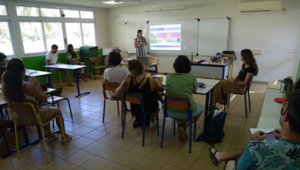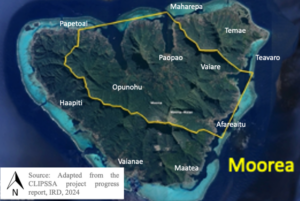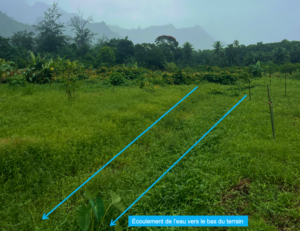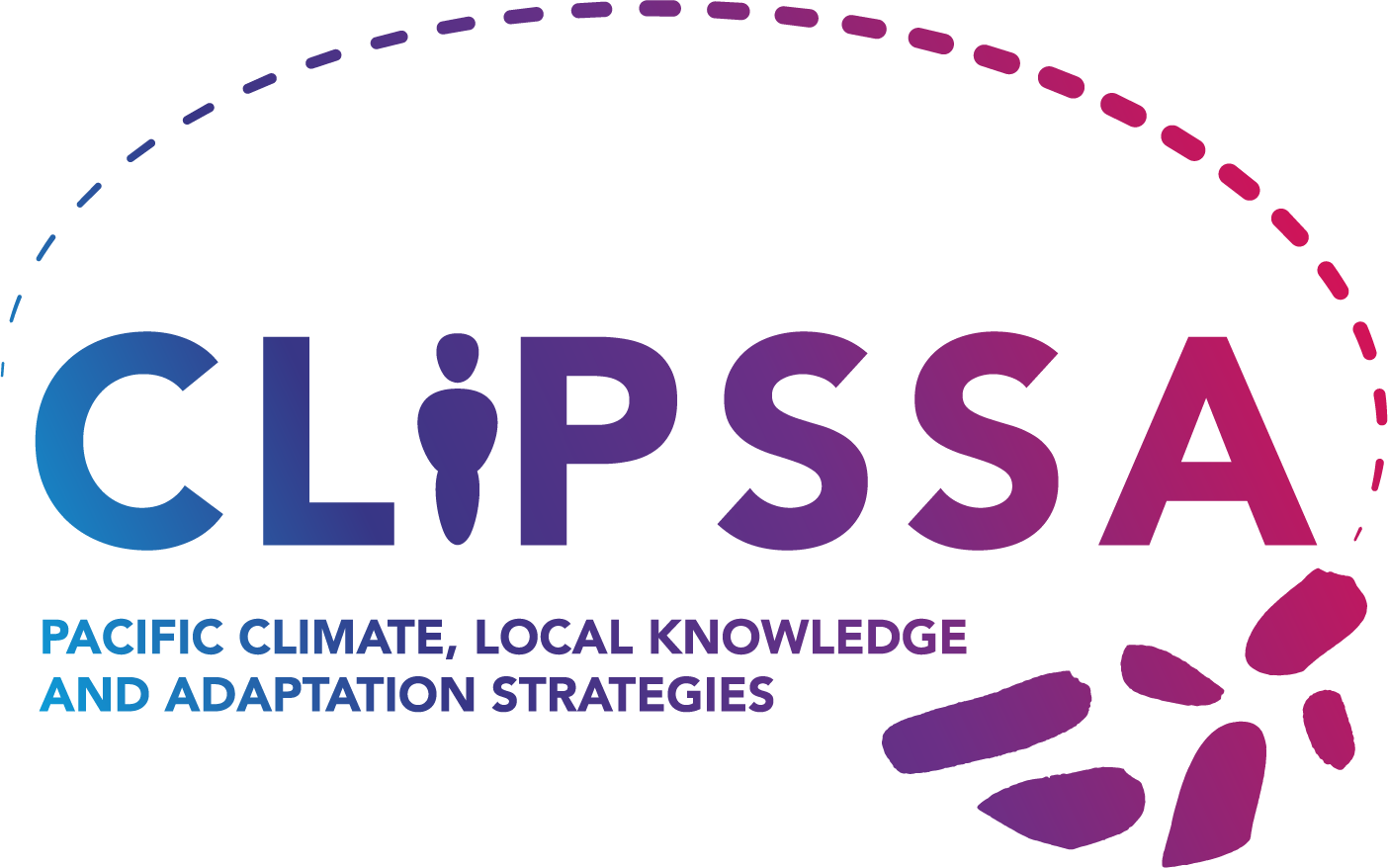Final Internship by Moeana PENLAE
University of French Polynesia – Master’s Degree (Year 2) in Biodiversity, Ecology and Environment, specialisation in Pacific Island Environments (BEE – EIO)
February – July 2025
Supervisors: Maya LECLERCQ (IRD), Catherine SABINOT (IRD)
Participated in the facilitation of 3 feedback workshops in Tahiti and Moorea in June and July 2025, bringing together agricultural students and local farmers met during fieldwork.

Figure 1: Photo of one of the feedback workshops held in Moorea with Agricultural BTS students and trainees in Agricultural Installation Training (FIA) at the Centre de Formation Professionnelle et de Promotion Agricole (CFPPA) of Opunohu (Source: Maya Leclercq, June 2025)
Article summary
Pacific island territories are particularly vulnerable to the effects of climate change, especially regarding small-scale agriculture, which is subject to challenges such as irregular rainfall, droughts, and fragile ecosystems. In this context, proper water management and the preservation of adapted agricultural knowledge are essential to ensuring food security. This study, conducted in Moorea as part of the CLIPSSA project, focuses on how farmers adapt to environmental challenges. Our team carried out interviews, field observations, and participatory workshops, highlighting a diversity of local strategies: the use of traditional environmental indicators, and innovative techniques such as drainage systems and composting. The study reveals two main types of agricultural knowledge: on one hand, ancestral knowledge transmitted orally or through observation—such as lunar cycles (tarena) or plant phenology; on the other, contemporary knowledge stemming from modern practices, shared via media, online videos, or training programs. Hybrid forms of knowledge transmission exist, where knowledge circulates through peer exchanges, social networks, or training programs that blend empirical practices with technical input. However, this knowledge is weakened by socio-economic constraints, such as the declining interest of youth in agriculture and difficulties in accessing land. This work thus highlights the vulnerabilities in the transmission of agricultural knowledge and underscores the importance of grounding adaptation policies in local realities.
Study context
High islands such as Moorea are particularly vulnerable to climate change: extreme rainfall, flooding, landslides, and prolonged droughts. These hazards threaten local food security and complicate water management, especially for sensitive crops like taro or vegetables. For this study, the research area covers a significant portion of Moorea, including an agricultural subdivision and the agricultural high school in the Opunohu valley, as well as valleys where subsistence farming is practiced.

Figure 2: Study site
In addition to climate-related challenges, farmers face several social constraints. Young people often turn away from agriculture, drawn to jobs perceived as more prestigious. Access to land remains difficult, with land often being shared or legally insecure. Finally, traditional knowledge is gradually disappearing as farmers age—the average age is 49 (RGA 2023)—threatening knowledge transmission and generational continuity.
The study is based on 18 semi-structured interviews conducted from mid-April to the end of May on the island of Moorea, involving institutional stakeholders (Department of Agriculture (DAG), Chamber of Agriculture and Lagoon Fisheries (CAPL), etc.), farmers, and informal discussions with roadside fruit and vegetable vendors.
Main results
The results highlight a diversity of adaptation practices that reflect both a strong cultural foundation and a high capacity for innovation:
- Water: A central issue
During periods of heavy rainfall (December–January in French Polynesia), excess water currently represents one of the main climate challenges for farmers in the Opunohu Valley, especially for sensitive crops such as taro, banana, or papaya, which suffer from soil saturation. In some areas, drainage systems (drainage ditch) or rainwater collection systems have been implemented, sometimes in a homemade manner. However, workshops conducted with farmers showed that this constraint is not shared by all: on sloped land, natural runoff allows water to drain more easily, thereby reducing the risk of waterlogging.

Figure 3: Photo of a drainage ditch dug on a farmer’s land in Opunohu (Moorea) to evacuate excess water (Source: Moeana Penlae, July 2025)
- Crop choices adapted to local context
Producers adapt their choices based on topography, soil quality, and water access: banana trees in humid areas, citrus trees on higher ground, and pineapples on dry terrain. Some diversify their crops to reduce risk.
- Knowledge in constant hybridization
Many farmers continue to use traditional indicators such as tarena or natural signs (plant phenology, appearance of insects indicating imminent rain, etc.). These indicators are combined with modern sources such as online tutorials, advice from the Department of Agriculture (DAG), or agricultural training (CFPPA).
- A strong connection to the land
The fa’a’apu is more than a field: it is a place of learning, memory, and identity. It embodies a sensitive relationship to the fenua, a Tahitian term generally referring to a country, land, or territory. It is often associated with everything related to the soil, the environment, or cultural belonging.
- Weakened knowledge transmission
Agricultural knowledge has traditionally been passed down through observation and hands-on practice between generations. Today, this transmission is fading, as young people are showing less interest in the agricultural sector, with the farming profession being undervalued.
Spending less to adapt
In a context of limited resources, farmers are developing low-cost and autonomous solutions, often outside institutional frameworks:
- Natural compost made from food scraps, banana leaves, plant waste, or fish waste
- Buried containers and repurposed tarps to store rainwater
- Raised beds or elevated growing areas to prevent water stagnation
- Crop associations to optimize soil moisture (e.g., planting banana trees around other crops)
It has been observed that, to cope with climate change, many farmers implement simple and inexpensive solutions, often created by themselves. In 1962, Claude Lévi-Strauss described the “bricoleur” as someone who creatively assembles available materials to solve problems—illustrating the inventiveness of these practices through flexible and resourceful thinking. These practices also reflect a certain degree of isolation: due to a lack of targeted support, adaptation often relies on individual efforts.
Conclusion
Agriculture in Moorea is currently shaped by multiple challenges: climatic, social, and institutional. Yet, farmers demonstrate active resilience by inventing new ways of farming, learning, and transmitting knowledge. This resilience is based on:
- A deep understanding of the environment
- An ability to experiment, adapt, and improvise
- A strong cultural attachment to the fenua
- A determination to preserve a way of life connected to the land
To strengthen this dynamic, it is urgent to:
- Recognize farmers as co-actors in climate adaptation
- Support modest solutions and local innovations
- Create spaces for intergenerational exchange
- Include local knowledge in public climate policies
Although rooted in Moorea, this research offers valuable lessons for other island territories. It shows that local agricultural knowledge is not a thing of the past, but a valuable resource for building a more resilient, self-reliant, and climate-adapted future.
